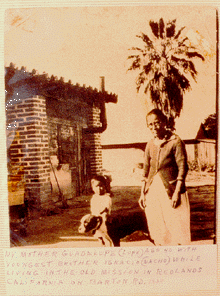

Don Lugo's RanchoThe name "Don" at the beginning of his name didn't stand for Donald. It meant that he was a respected landowner, similar to our "Sir". Don Lugo's sons moved their families and thousands of head of cattle into San Bernardino valley. They built a nice adobe home across the valley from the old mission. You could probably see it today, except the San Bernardino County Courthouse is built on top of the site! |
To build an adobe house, you must make make hundreds of mud bricks. This workman is making adobe bricks for the rebuilding of the estancia in 1938.
San Bernardino County Museum |
The Indians are Friendly...Right?Don Lugo's problems started right away. He found out that a lot of the Indians were hungry since the Mission was abandoned. They liked eating his cattle, and didn't have any money to pay for them. Don Lugo didn't want to lose his cattle, so he asked the governor to send a priest back to the mission, to teach the Indians right and wrong and to help them grow their own food. Then they wouldn't have to take his cattle. The governor never answered his letter! Don Lugo's son, Jose del Carmen Lugo, moved his family into the old estancia. He probably wanted to keep an eye on the Indian village that was nearby. No one is too sure how well that strategy worked, but Don Lugo had other problems. It takes a lot of horses to run a cattle ranch. The Mojave Indians from the desert had heard about a new cattle ranch with lots of horses. Time after time they raided his corrals and stole his horses. Horses were expensive. This was cutting into his profits. He hired people to keep watch over the Cajon Pass and stop the stealing, but the Mojaves kept raiding the ranch. Things got so bad that Don Lugo started thinking about a way to get out of the ranching business here. |
A mother (Guadalupe) and child (Ignacio) lived in the old Mission estancia during the early part of this century, just as Jose del Carmen Lugo had in 1843.The old buildings have been home to many people over the years. They have also housed a school, a furniture factory and sheep.
|